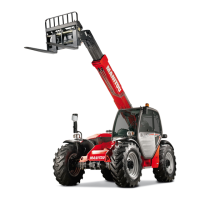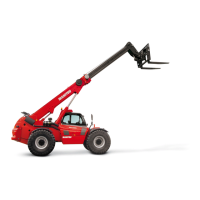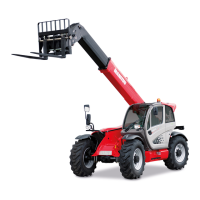LOAD HANDLING
A - WEIGHT OF LOAD AND CENTER OF GRAVITY
- Before taking up a load, you must know its weight and its center of gravity.
- The load chart relating to your lift truck is valid for a weight with its center of
gravity 24 in from the heel of the forks (Fig. A). For a higher center of
gravity, consult your agent or dealer.
- For irregular loads, determine the center of gravity in the transverse
direction before handling (Fig. B).
B - TAKING UP A LOAD ON THE GROUND
- Position the lift truck perpendicular to the load, with the boom retracted and
the forks in a horizontal position (Fig. C).
- Adjust the fork spread and centering in connection with the load (Fig. D)
(Optional solutions exist, consult your dealer).
- Move the lift truck forward slowly (1) and bring the forks to stop in front of
the load (Fig. E), if necessary, slightly lift the boom (2) while taking up the
load.
- Apply the parking brake and place the forward/reverse lever in neutral.
- Slightly lift the load (1), incline the carriage (2) backwards in the transport
position (Fig. F).
CAUTION
1 - 13
A
B
C
D
E
F
Carrying a load greater than the rated capacity for the
lift truck or for the attachment is prohibited.
CAUTION
For loads with a moving center of gravity (e.g. liquids), take account of the
variations in the center of gravity in order to determine the load to be
handled (Consult your agent or dealer) and be vigilant and take extra care
to limit these variations as far as possible.
WARNING
Beware of the risks of trapping or injuring limbs when manually adjusting the
forks. Always maintain an equal distance between the forks and the center
of the carriage in order to keep the load completely stable.
CAUTION
Tilt the load sufficiently backwards to ensure its stability (loss of load on
braking) without upsetting the balance of the load in so doing.

